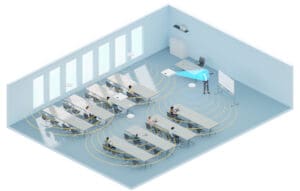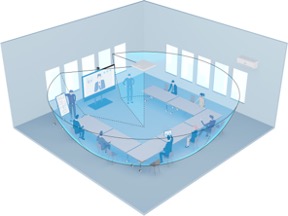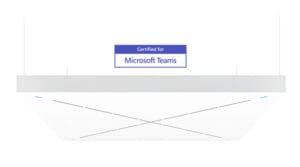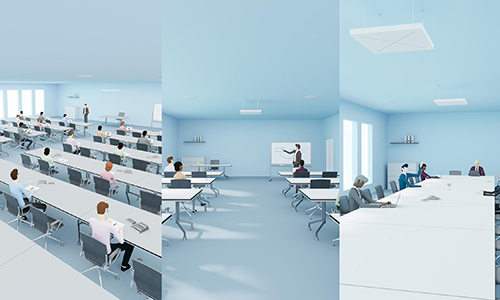By Jens Werner, Portfolio Manager Business Communication at Sennheiser
Apart from the obvious restrictions in communication and being able to understand each other clearly whilst physically far apart, several factors such as colleagues joining remotely, chatty students, air conditioner noise, repetitive sounds like typing and tapping as well as poor room acoustics may have a significant impact on how people interact with a presenter and each other.
With companies and educational organizations looking to adapt their current spaces to the new requirements, re-evaluating existing A/V equipment becomes crucial.
Looking at the bigger picture
With some joining meetings or seminars in person and others participating virtually via conferencing apps such as Zoom or Microsoft Teams, an effective audio ecosystem can be created which not only links virtual attendees with the presenter, but also looks at the bigger picture: ensuring good quality audio in the room between all physical members, as well as connecting in-room members with virtual participants. All groups need to be able to freely interact with each other and hear each other well no matter whether they are online or where the person is sitting in the meeting room or auditorium.
Voice lift technology plays a crucial role in achieving the latter. It uses the components of a traditional sound system in order to deliver voice amplification for all participants in a room. The beauty of such a system is that it increases the speech level by just a few dB to account for decreased speech intelligibility due to the distance between people in the room. The effect is so subtle that it is often not even noticed by physical attendees, let alone virtual participants.
Like a conventional sound reinforcement system, voice lift technology needs components such as microphones, amplifiers, digital signal processors and loudspeakers. And – in times of Covid-19 and beyond – it is the microphone side that presents the most convenient option for optimising a voice lift system.
How a ceiling microphone can optimise your voice lift system
Ceiling microphones ensure ‘touchless audio’ through their beamforming microphone array technology – no need to pass around or share microphones. Not only does a ceiling microphone allow for a safe social distance between all participants, it also encourages both physical and virtual interaction between all participating groups, making conferences, lectures and seminars feel much more natural.

A ceiling microphone in a voice lift system ensures touchless operation and added convenience for the lecturer
The convenience for speakers and lecturers should not be underestimated either: They can simply walk into the room and know that everything works without the need to locate a handheld microphone, attach a lapel microphone or stay in front of a table top mic. They can simply focus on their presentation or lecture, hands-free, with the re-assuring feeling that everybody in the room or connected remotely will understand them perfectly.
In this context, Sennheiser’s TeamConnect Ceiling 2 (TCC2) is a particularly appealing solution. Its automatic adaptive beamforming technology follows the active speaker’s voice, allowing them to speak naturally whether they are sitting, standing, or moving around. Meetings and classes become totally flexible – it’s no problem to have more speakers than planned, and interaction in the room is lifelike. This also helps remote participants or distance students to feel an integral part of a normal meeting or seminar.
Recently, TeamConnect Ceiling 2 has been expanded by TruVoicelift, a free feature that has added another use case to TCC2: clear in-room audio. This new technology is not a mere add-on but has been endowed with several features to allow for a quality listening experience:

TeamConnect Ceiling 2 ensures flexible and lifelike lectures and meetings, making distance students or remote meeting participants feel an integral part of the event
TruVoicelift is powered by an advanced frequency shift algorithm. Thanks to this algorithm – and unlike standard voice lift systems, TCC2 is able to deliver higher gain before feedback – which can make all the difference to perfectly hearing a speaker.
A feedback prevention mute function means that if audio levels are too loud, TCC2 will briefly mute itself to prevent any unwanted feedback.
In any conversation that involves several speakers, there may be times when there are pauses in speech. With TruVoicelift, if a pre-defined audio threshold is not reached, a noise gate will be handily activated that mutes TCC2 to prevent any background noise such as chatter from being amplified.
In every space, there may be areas where audio should be predominantly picked up, such as the front of a lecture hall. By making this area a so-called “priority zone”, the microphone will focus on this zone when an audio signal is present and not pick up peripheral chatter in other parts of the room.
On the other hand, there may be areas where noise sources need to be excluded, like air conditioning units or ventilation equipment. With TruVoicelift this can be easily resolved by determining “advanced exclusion zones”.

Graphical representation of the TCC2 coverage area (blue) within a meeting room, with exclusion zones defined. The zones have been chosen such as to eliminate noise from the air conditioning on the right-hand side and to not pick up sound from the screen’s loudspeakers
Open ecosystems save additional investment and create the best possible technical solution
From an installation and IT perspective, an open system like TCC2 that can be integrated with any other ecosystem already in place is ideal. Not only does such a system work seamlessly with existing setups, it will still be compatible if the platform is changed. And besides saving additional investments, an open system makes it possible to combine the optimum products for the job at hand. Choosing products that have, for example, Microsoft Teams certification and Zoom certification is a good starting point and ensures a system can be up and running instantly.
Being able to easily configure TCC2 and TruVoicelift via the free Sennheiser Control Cockpit software gives another benefit to IT staff as microphone settings can be controlled from a central location. The ceiling microphone also supports Dante Domain Manager.

TeamConnect Ceiling 2 is compatible with all leading video collaboration platforms. Via its open protocol, TCC2 can be flexibly integrated into any other ecosystem already in place
TCC2 is compatible with all leading video collaboration platforms, as well as offering additional benefits to businesses and institutions with existing Q-SYS Ecosystems. These can use the QSC plugin to easily configure and manage the microphone. Similarly, TCC2’s full compatibility with Crestron’s control system platform enables remote access to the ceiling microphone’s audio parameters, mute and customisable LED control. With Bose Professional and the ES1 and DS4 ceiling audio solutions, a powerful in-ceiling conferencing solution is in place. Also, TeamConnect Ceiling 2 is fully compatible with Extron AV technology solutions.
Via its open protocol, TCC2 can be flexibly integrated into any other solution, too. An attractive option is to also use TCC2 for camera control. Here, the advanced real-time positioning data of the ceiling mic are used to capture the video of the active speaker for remote participants, making hybrid meetings or lectures much more engaging and natural for remote participants.
A look into the future
Hybrid meetings and seminars are here to stay: The advantages they offer for corporations and higher education facilities beyond touchless audio and convenience are obvious. For universities, remote students have become an additional source of income, and offering sophisticated solutions for remote participation will make courses more attractive for distance students. Businesses can have their teams meet and exchange with international experts and customers more regularly. While an initial meeting may be in-person to get to know each other, the follow-ups could be done remotely – and, with the right technology, as naturally as possible.
Adding voice-lift technology will make these hybrid experiences agreeable for the teams and students on site: Remote audio is clearly understandable anywhere in the room, and a presenter is clearly heard no matter how far one may be seated from them.
The combination of ceiling microphone and voice lift system delivers a very natural and seamless communication experience between all members of the discussion, whether situated in the same room or participating remotely.
The high-resolution graphics accompanying this article can be downloaded here.
About Sennheiser
Shaping the future of audio and creating unique sound experiences for customers – this aim unites Sennheiser employees and partners worldwide. Founded in 1945, Sennheiser is one of the world’s leading manufacturers of headphones, loudspeakers, microphones and wireless transmission systems. Since 2013, Sennheiser has been managed by Daniel Sennheiser and Dr. Andreas Sennheiser, the third generation of the family to run the company. In 2019, the Sennheiser Group generated turnover totaling €756.7 million. www.sennheiser.com





